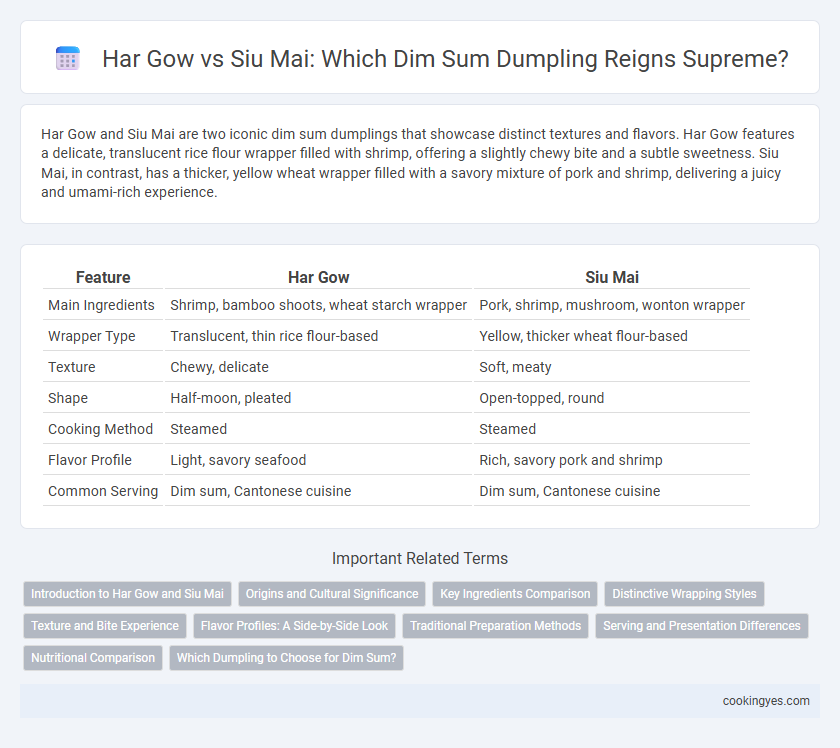Har Gow and Siu Mai are two iconic dim sum dumplings that showcase distinct textures and flavors. Har Gow features a delicate, translucent rice flour wrapper filled with shrimp, offering a slightly chewy bite and a subtle sweetness. Siu Mai, in contrast, has a thicker, yellow wheat wrapper filled with a savory mixture of pork and shrimp, delivering a juicy and umami-rich experience.
Table of Comparison
| Feature | Har Gow | Siu Mai |
|---|---|---|
| Main Ingredients | Shrimp, bamboo shoots, wheat starch wrapper | Pork, shrimp, mushroom, wonton wrapper |
| Wrapper Type | Translucent, thin rice flour-based | Yellow, thicker wheat flour-based |
| Texture | Chewy, delicate | Soft, meaty |
| Shape | Half-moon, pleated | Open-topped, round |
| Cooking Method | Steamed | Steamed |
| Flavor Profile | Light, savory seafood | Rich, savory pork and shrimp |
| Common Serving | Dim sum, Cantonese cuisine | Dim sum, Cantonese cuisine |
Introduction to Har Gow and Siu Mai
Har Gow and Siu Mai are iconic dim sum dumplings distinguished by their unique fillings and textures, with Har Gow featuring translucent wrappers filled with shrimp and bamboo shoots that offer a delicate, slightly chewy bite. Siu Mai, on the other hand, contains a savory mixture of ground pork, shrimp, and mushrooms wrapped in thin wheat flour wrappers, resulting in a juicy and flavorful experience. Both dumplings highlight traditional Cantonese culinary craftsmanship and remain staples in authentic dim sum cuisine.
Origins and Cultural Significance
Har Gow originated from Guangdong province and is known for its translucent wrapper filled with shrimp, symbolizing freshness and delicacy in Cantonese dim sum culture. Siu Mai, also hailing from Guangdong, features an open-top design with pork and mushroom filling, representing prosperity and wealth during traditional Chinese celebrations. Both dumplings showcase regional culinary artistry and hold important roles in the ritualistic experience of dim sum dining.
Key Ingredients Comparison
Har Gow dumplings feature a translucent, delicate rice flour wrapper encasing a filling primarily of succulent shrimp mixed with bamboo shoots and a touch of pork fat for moisture. Siu Mai showcases a yellow wheat-based wrapper filled with a savory blend of ground pork, whole or chopped shrimp, and often mushrooms or water chestnuts for added texture. Both highlight a seafood-meat combination, but Har Gow emphasizes shrimp dominance, while Siu Mai balances pork and shrimp with more varied fillings.
Distinctive Wrapping Styles
Har Gow features a translucent, thin wheat starch wrapper that is pleated into crescent shapes, highlighting its delicate shrimp filling. Siu Mai uses a thicker, yellow wheat wrapper shaped like an open-topped cup, exposing a pork and shrimp mixture garnished with roe or mushroom. These distinctive wrapping styles not only differentiate the dumplings visually but also influence their texture and culinary experience in dim sum cuisine.
Texture and Bite Experience
Har Gow offers a smooth, translucent wrapper with a delicate, slightly chewy texture that reveals a juicy shrimp filling, creating a satisfying bite with a light snap. Siu Mai features a tender yet firmer wonton wrapper encasing a savory pork and shrimp mixture, delivering a heartier, more robust bite experience. The contrast between Har Gow's silky softness and Siu Mai's meaty density highlights distinct textural pleasures in classic dim sum dining.
Flavor Profiles: A Side-by-Side Look
Har Gow features a delicate, translucent wrapper encasing a tender shrimp filling that offers a subtle sweetness and a slight briny taste, highlighting fresh seafood flavors. Siu Mai presents a more robust profile with its open-top steamed dumpling filled with ground pork and shrimp, seasoned with ginger, soy sauce, and sesame oil, delivering a savory, umami-rich experience. The contrast between Har Gow's light, refreshing notes and Siu Mai's flavorful, meaty depth makes both essential yet distinct components of dim sum dining.
Traditional Preparation Methods
Har Gow and Siu Mai, both iconic Cantonese dim sum dumplings, showcase distinct traditional preparation methods emphasizing texture and flavor. Har Gow features a translucent wheat starch and tapioca-based wrapper encasing a shrimp filling, requiring skilled hand-folding to create delicate pleats without tearing. Siu Mai uses a thicker wonton wrapper made from wheat flour, filled with a mixture of pork, shrimp, and mushrooms, then topped with roe or carrot, steam-cooked to achieve a tender yet firm bite.
Serving and Presentation Differences
Har Gow dumplings are typically served in delicate bamboo steamers, showcasing translucent wrappers that reveal plump shrimp fillings, emphasizing a light and elegant presentation. Siu Mai dumplings often appear with open tops, displaying a vibrant mixture of pork, shrimp, and mushrooms, garnished with roe or carrot bits for added color and texture appeal. The serving style differentiates with Har Gow's emphasis on simplicity and refinement, while Siu Mai offers a hearty, visually dynamic presentation that highlights its robust ingredients.
Nutritional Comparison
Har Gow and Siu Mai are popular dim sum dumplings with distinct nutritional profiles. Har Gow typically contains shrimp and has fewer calories and less fat, making it a lighter choice rich in protein and low in carbohydrates. In contrast, Siu Mai is often filled with pork and shrimp, providing higher protein and iron content but also increased fat and calorie levels, making it more calorie-dense.
Which Dumpling to Choose for Dim Sum?
Har Gow offers a translucent, delicate shrimp filling wrapped in a thin rice flour skin, ideal for those seeking a light, fragrant dim sum experience. Siu Mai features a robust pork and shrimp mixture, topped with roe or mushroom, providing a richer texture and savory flavor that satisfies hearty appetites. Choosing between Har Gow and Siu Mai depends on preference for subtle sweetness and slipperiness versus a more filling, umami-packed bite.
Har Gow vs Siu Mai for dim sum dumplings Infographic

 cookingyes.com
cookingyes.com